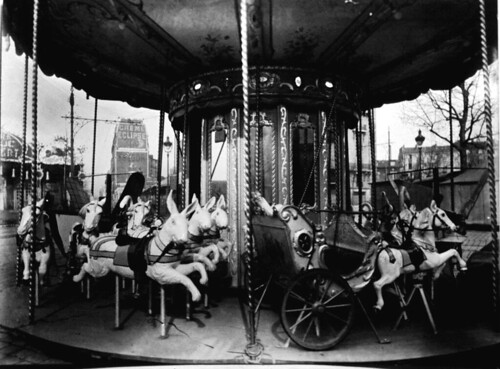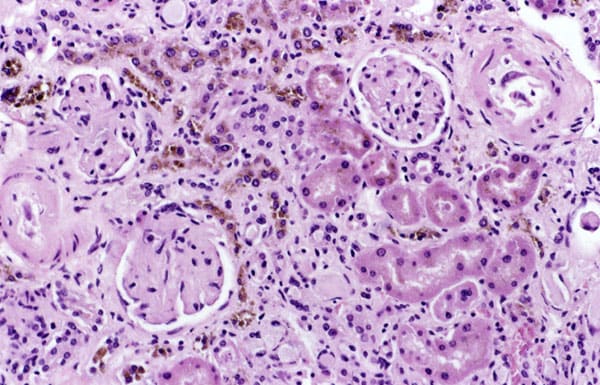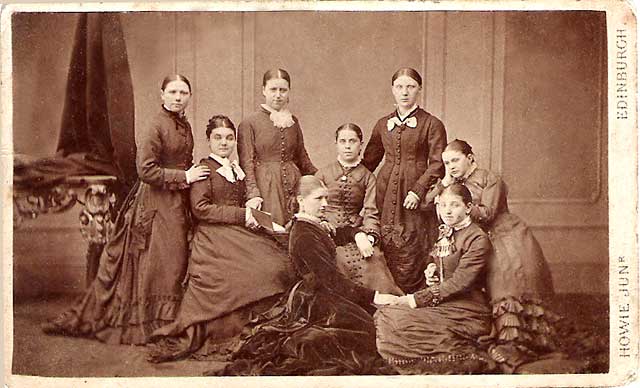Wednesday, April 28, 2010
Wednesday, April 21, 2010
Family of Man
After perusing my Family of Man magazine (I recently found a copy of the original magazine from the 1950's at a book sale) I found countless images that I absolutely loved. This one image in particular really left a big impression on me:
 Jerry Cooke, Life
Jerry Cooke, Life
 Jerry Cooke, Life
Jerry Cooke, LifeI feel so much emotion coming through in this photograph taken by Jerry Cooke. The girl in the photo looks completely heartbroken and alone. The compostion is exquisite and also adds to the feeling of lonliness that comes across in the photograph- the girl sits near the bottom of the frame while the vast black wall fills up most of the photograph.
Monday, April 19, 2010
Photography in the Atomic Age
This is a very striking image. I love how the stark white body of the child is placed in the foreground amidst the dark, shadowy landscape that stretches out behind the figure of the child. The light in this photo seems to hit in just the right spots, making the photo have an overall magical and surreal feel to it.
Monday, April 12, 2010
Photojournalism as Art
This photograph taken by Eddie Adams during the Vietnam War is perhaps one of the most famous photographs of all time. This photograph was taken from a photojournalist's perspective, but it is also recognized for its artistic photographic qualities. The heart-wrenching emotion captured in this photograph is undeniable; one knows that in a single moment this Vietnamese man will be shot dead. Due to its superior photographic qualities, this photo became an iconic image of the Vietnam War.
Friday, April 9, 2010
Nabbing Time
During the 20th century, faster shutter speeds made it possible for photographer to capture moments they had never captured before. Photographers could now photograph split seconds in time and an entirely different world of photography opened up. The above photo was taken by Harold Edgerton. Edgerton experimented with this notion of a split second in time, and he even took that idea a step further by taking photos of occurrences that happen so quickly that the human eye can't even see them. In the above photo, a bullet has just been shot through an apple that is actually resting atop another bullet. Surely the bullet holding up the apple would have fallen down after this photo was snapped. The photography of Harold Edgerton is a perfect example of how photographers of the 20th century began to take photos that "nabbed" time.
Wednesday, April 7, 2010
Social Documents
In the beginning of the twentieth century, photographers began using photography as a method of documenting the filthy conditions that some people lived in as well as some of the hardships they had to go through. The living conditions of American immigrants was a popular subject, and some of these photos were used as "social documents" and used as evidence in various courts around the nation. In the The above photograph is part of a series by E. J. Bellocq. Bellocq wanted to showcase the lives of prostitutes in New Orleans and the terrible conditions they lived in. In the above photo, the prostitute is depicted in a dingy hotel room. She is wearing a mask, which I believes makes the woman a more universal figure.
Monday, April 5, 2010
Eugene Atget

Above is a photo that I took in downtown Macon a couple of years ago. This photograph is something that I believe Eugene Atget would definitely approve of. First of all, the photo has urban subject matter, which Atget delved plentifully in. Also, the alley feels completely deserted and as that eeriness to it that so many Atget photographs have. The fact that the alley seems to stretch backwards nearly infinitely only makes it seem more surreal and eerie.
Friday, April 2, 2010
Cliche Verre
Cliche Verre is a technique that artist Max Ernst used where he etched an image on something such as glass or film, and then printed the image on light sensitive paper. I really like the cliche verre pictured above that I discovered on the internet. I like how abstract the image is. Apparently the image is made from salt, sugar, charcoal, and ink, but you could never tell just from looking at the image. All of these different elements combined together make for a very interesting final product that really catches the eye.
Wednesday, March 31, 2010
Cyanotype Project
For my cyanotype project, I know that I want to put two images on one negative and create borders around them. The two images will be of similar content. I want my images to come out looking very similar to this image that I found on the internet (pictured above).
I plan on using photos that I have already taken, such as photos of downtown Macon and photos of Rose Hill Cemetery.
I plan on using photos that I have already taken, such as photos of downtown Macon and photos of Rose Hill Cemetery.
Monday, March 29, 2010
Collage
 Hannah Hoch
Hannah HochI'm not sure what Hannah Hoch was trying to say with this collage, but I find the image pretty striking and hilarious. It also has an undoubtedly surreal quality to it- cut outs of heads are randomly placed atop the legs of two different women. This collage is bizarre, and I find the bizarre very intriguing.
Friday, March 26, 2010
Man With a Movie Camera
I chose this still from Man with a Movie camera because it exhibits one of the first uses of the split screen. In the film, many other new techniques are explored, such as stop motion animation. This split screen still also is a good shot of street life in Russia- it gives the audience a glimpse of what life in Russia was like at the end of the 1920's.
Wednesday, March 24, 2010
A Trip to the Moon
I really love George Méliès's film, A Trip to the Moon. I love all of the trick photography throughout the film, and I also love how hilarious the actual film is. Before viewing this film, I really did not expect it to be so full of humor. The film still of the moon above displays this humor- the moon has an actual human faces imposed on it, and it is also hilarious that the space shuttle in the film has landed right on his eye.
Monday, March 22, 2010
Lumiere Film
Arrival of a Train at La Ciotat, Lumière Brothers, 1895
This Lumiere film of the train arriving at the station is my favorite. I like how the platform in the station in nearly completely deserted in the beginning. When the train arrives, the film gets more and more entertaining as people start boarding and getting off of the train. What also makes this film is interesting is that it gives us a glimpse of what everyday life was life at the turn of the century. This film lets us see one of America's great technological achievements, the train, in action.
Friday, March 19, 2010
My Cubist Creation: Apple
Wednesday, March 17, 2010
Photography and Modernism
I think that it's wonderful how photography inspired the art movement of Cubism. Photography allowed artists to see everyday objects in an entirely different light, so it was really only a matter of time until photography seeped into the lives of artists, and, in particular, the painters of the twentieth century. For the movement of Cubsim, photography allowed artists to see ordinary things from severe\al different angles, thus artists began to portray these depictions of different viewing in their painings (such as the Braque painting displayed above). It's interesting how photography inspired painting in the early 1900's when just in the late 1800's painting inspired photography during the movement of pictorialism.
Monday, March 15, 2010
Pictorialism: Women Photographers
The Heart of the Storm is an incredibly visually striking photograph. The image is definitely very painterly- one can barely tell that this is a photograph upon first glance. This photo fits in perfectly with the pictorialist movement; it looks so much like a painting that it almost appears as if it contains brush strokes. This image is very powerful. Two figures are embracing one another in the midst of a storm. I'm not quite sure what the intended subject matter here is, but when I look at this photo I feel a great sense of sorrow. However, I also feel a hint of hope. These two figure are caught in the heart of the storm, yet they still have eachother to cling to, and that is where the hope comes in. I wonder how Brigman captured this image, because this is just such a stunning shot and even today this image would be a difficult moment to capture.
Wednesday, March 3, 2010
Pictorialism and Naturalism
 George Seeley, Black Bowl, 1907
George Seeley, Black Bowl, 1907I think that this photograph created by George Seeley perfectly embodies the pictorialism and naturalism movements in photography. The pictorialists sought to create photos that resembles the paintings of the time, and this photo has a very painterly feel to it. The image is blurred, giving it a very ethereal quality. This photograph also relates to the movement of naturalism; the woman in the painting is very naturally posed and seems ordinarily human. The light source for the photograph also seems very naturalistic. There is no artificial light, just the natural light coming from one source.
Monday, March 1, 2010
Technological Breakthroughs at the Turn of the Century
Alfonse Van Besten, Modesty, 1912, autochrome
Kinetoscope, invented by Thomas Edison in 1888
The kinetoscope and the autochrome represent two technological innovations that really changed the way people thought in the late 1800's. The autochrome was the first successful colored photograph. With the invention of the autochrome, people were able to see the images they shot in color for the first time, thus opening up the entire world of color to photographers.
The Kinetoscope, invented by Thomas Edison in 1888, was a the first widely marketed machine used to view motion pictures. The films played when someone peered into the Kinetoscope were only one and a half minutes long, but they had a great effect on the viewer. Because of the invention of the Kinetoscope, the masses were able to view their world in motion.
The Kinetoscope, invented by Thomas Edison in 1888, was a the first widely marketed machine used to view motion pictures. The films played when someone peered into the Kinetoscope were only one and a half minutes long, but they had a great effect on the viewer. Because of the invention of the Kinetoscope, the masses were able to view their world in motion.
Friday, February 26, 2010
Eadweard Muybridge
 Eadweard Muybridge, Jumping; over boy's back (leap-frog), 18884-1847
Eadweard Muybridge, Jumping; over boy's back (leap-frog), 18884-1847This set of images by Eadweard Mubridge depicts a one boy jumping over the others back. I find this really interesting, because first of all, I think this feat of leap frogging while standing is pretty incredible. Also, it's funny how the boy who is being jumped over seems completely emotionless and unaware that someone is jumping over his head. It's very interesting to see the various position that the jumping boy's body is in; not only his body in the air, but also the position of his body prior to the jump. His body, when frozen in time, appears to be leaning slightly backwards before he jumps, which is odd.
Wednesday, February 24, 2010
Charles Baudelaire
At a photography convention in 1859, Charles Baudelaire famously said "Let [photography] rescue from oblivion those tumbling ruins, those books, prints and manuscripts which time is devouring, precious things whose form is dissolving and which demand a place in the archives of our memory - it will be thanked and applauded.But if it is allowed to encroach upon the domain of the... imaginary, upon anything whose value depends solely upon the addition of something of a man's soul, then it will be so much the worse for us."
Although Baudelaire did not approve of photography as a whole, I believe he would have approved of this image:
Although Baudelaire did not approve of photography as a whole, I believe he would have approved of this image:
This is simply a photographic image of a kidney viewed under a microscope. I think that Baudelaire would definitely approve of this image because he was all for photography used as an aid for science rather than photography being used as a form of art.
Monday, February 22, 2010
Photo on Campus

I found this photo on campus at the bottom of a stairwell in Connell Student Center. I chose it because I really like the dapper outfits all of the men are wearing. This photo does have a whimsical and mysterious feel to it. I wonder what exactly these men, probably Mercer students, were posing for, which adds to the mysterious quality of the photo. It's also really cool to see a small glimpse of what downtown Macon looked like back in the day. I like the composition of this photo, too; the men on the viewer's right are closet to the photographer, while the men towards the left recede into the background.
Friday, February 19, 2010
Civil War Photograph
 Antietam, Maryland. Septermber 1862.
Antietam, Maryland. Septermber 1862.During the Civil War, photographers utilized the medium of photography to capture the hardships and casualties of battle. The above photo, taken at the battle of Antietam, is very shocking. It depicts a seemingly infinite line of the bodies of dead soldiers. I chose this particular Civil War photograph because I loved the composition- how the endless amount of bodies curves in from the left of the frame and then stops in the center. Despite the depressing subject matter, I think the composition is lovely.
Thursday, February 18, 2010
My Photo Book: Eugene Atget

Prostitute on Her Shift, rue Asselin, La Villette- Eugene Atget (1921)
Eugene Atget was a photographer living and working in Paris at the turn of the 19th century who is best known for taking photos of the people and the sites around the streets of Paris. Many of Atget's photos were labeled as "provocative", such as the above photograph, Prostitute. He consistently used the albumen and gelatin silver techniques, refusing to change over to newer photographic technologies that came about during his lifetime. Atget wasn't a particularly well known photographer when he was living; however, after his death, several of his admirers and colleagues worked to get his name out there. As a result, Atget became recognized as one of the most important photographers of the early 20th century.
Monday, February 15, 2010
Photojournalism
The above images are from the 19th century and mark the true beginning of photojournalism. However, these photos are very different from the journalism photos we see today. In the modern era, journalism photos tend to be rather busy and seem to attempt to capture a specific action at a precise moment. Modern photojournalists seek to snap the most exciting and intriguing moments of everyday life events. Contrary to the photos taken by photojournalists today, the above photos are very calm and even atmospheric. The photos are still intriguing, yet they only focus on one persona and they lack any exciting action. The photos from the 19th century also feel much more intimate, capturing these figures in very personal moments. Also, it seems like these days in photojournalism more emphasis is placed on the subject rather than on the composition, but in the 19th century photos it appears that composition still played a large role in the field of photojournalism.
Friday, February 12, 2010
"The Snowflake Man"

Snow Crystal- William A. Bentley, 1902
What William A. Bentley did for the worlds of both science and photography is really great. I can only imagine that Bentley's microscopic snowflake were the predecessors to macro photography as we know it today, as well as the precursor to the modern day microscope. Bentley combines the fields of art and science in order to make scientific discovery, making beautiful photographic images all along the way.
Wednesday, February 10, 2010
Stereo Photograph

I really love this stereo photograph, but I could not find the name of the photographer. I like how it is of ordinary, every day subject matter. It depicts the lives of a typical family from this era, a family who most likely viewed stereo photographs themselves. I like how the curtains in the background add some interest to the photograph.
Monday, February 8, 2010
Mid-18th Century Collages
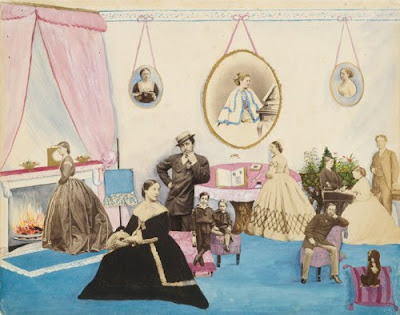
Untitled, loose paper from the Filmer Album, collage of watercolor and albumen prints- Paul F. Walter (mid-1860's)
I absolutely love these collages from the Metropoltian Museum of Art's exhibition "Playing With Pictures". They're all very whimsical and have a surrealist quality to them. In a way, this way of collaging can be thought of as the precursor to scrap booking, However, scrap booking enthusiasts definitely do not cut out pictures of their friends and family and place them on made up painted backgrounds. I would really like to try make a modern day version of this 19th century collaging hobby.
Friday, February 5, 2010
Pictured above are both a carte de visite and an ambrotype. Both of these images were made around the same time period, yet they both have completely different effects on the viewer. The carte de visite depicts a somewhat wealthy 19th century family. The carte de visite has a much more pleasant subject matter than the ambrotype on the bottom. which shows a deceased baby. Although the subject matter varies, both of these photographs were created with the same purpose in mind- to create a memory. The photo on the top serves as a record of the family, and the bottom ambrotype serves as a record of a deceased child.
Wednesday, February 3, 2010
Large Format Photography

Emily Gomez, from Unearthed
This is my favorite large format photograph from Emily Gomez's exhibit "Unearthed". I think this eimage is really beautiful. I really love everything about it-the light, composition, contrast, mood, etc. Out of all of the images in "Unearthed", this photograph definitely had the most impact on me. I find it very powerful yet mysterious.
Monday, February 1, 2010
Romanticism: Beautiful & Sublime
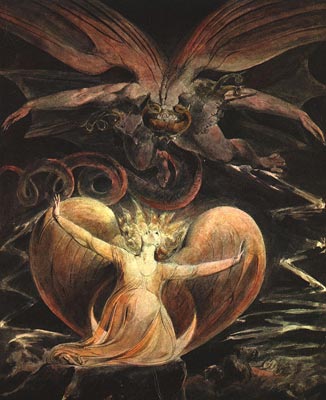 William Blake, The Great Red Dragon and the Woman Clothed with the Sub, 1805
William Blake, The Great Red Dragon and the Woman Clothed with the Sub, 1805The two images above represent the aesthetics of the Romantcism movement in the 19th century. The Romantics sought to portray the sublime and the beautiful through their artwork. The photograph represents the beautiful while the painting by Blake represents the sublime.
The photograph by Talbot represents the beautiful rather than the sublime because it exhibits a softness. This softness is due to the soft light that radiates throughout the composition. The composition itself is very proportional, which creates an overall peaceful effect in the photograph.
The painting, on the other hand, depicts the sublime. It's more powerful than the photograph and contains elements of storminess and terror. That demon near the top of the frame is definitely terrifying. Vastness, another characteristic of the sublime, is also present and is represents by the blackness that surrounds the figures in the painting.
The photograph by Talbot represents the beautiful rather than the sublime because it exhibits a softness. This softness is due to the soft light that radiates throughout the composition. The composition itself is very proportional, which creates an overall peaceful effect in the photograph.
The painting, on the other hand, depicts the sublime. It's more powerful than the photograph and contains elements of storminess and terror. That demon near the top of the frame is definitely terrifying. Vastness, another characteristic of the sublime, is also present and is represents by the blackness that surrounds the figures in the painting.
Friday, January 29, 2010
Calotype

The Artist and the Gravedigger- Robert Adamson & D. O. Hill (mid 1840's)
I chose this calotype because I think the subject matter is very intriguing. This photograph, taken in Edinburgh, Scotland, has the title "The Artist and the Gravedigger", which still doesn't tell the viewer much about what exactly is taking place in the photograph. The ambiguity and also the uniqueness of the subject matter is what drew me to this calotype.
Wednesday, January 27, 2010
The Daguerreotype & Science
 John Adams Whipple, Moon, 1851
John Adams Whipple, Moon, 1851During the mid 1800's, when the daguerreotype came along, is when photography began seeping into the world of science. John Adams Whipple was one of the main photographers who overlapped photography with sciences, taking an entire series of the moon. This is but one of the many moon photos that Whipple took. I think it's a really great photograph- I love how Whipple caught the moon in partial shadow.
Monday, January 25, 2010
Friday, January 22, 2010
Photogram

Man Ray, 1922
A photogram is an image that is made simply by placing various objects onto photographic paper and then exposing the paper to light. I chose this particular photogram produced by Man Ray, probably the most well known artists who produced photograms, because I love this composition. I like how the forms on this photgrams are abstracted-most photograms are composed of small recognizable objects, yet the subject if this photogram is indiscernible.
Friday, January 15, 2010
Camera Obscura

The Pantheon in the Hotel Des Grands Hommes, 1999- Abelardo Morell
Abelardo Morell has created so many great photographs using the camera obscura. He travels around the world, turning hotel rooms into his own personal cameras. This particular photograph, taken in Rome, is one of my favorite from Morell. The ancient city of Rome stretches out next to the right of the beds, creating a wonderful composition. The curves found in the ironwork of the beds looks very nice when placed next to the city projected on the wall.
Subscribe to:
Posts (Atom)



